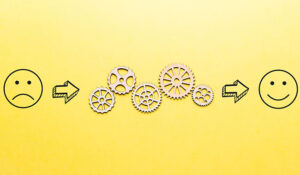Brian Mistretta at NICE CXone outlines how digital transformation addresses five of the top customer expectations.
Did you ever see the episode of “Friends” where the always-principled Phoebe Buffay spends the entire show on hold with her phone company’s customer service?
Here’s the run-down: It’s 1997 and Phoebe has a broken landline and a soon-to-be-expired warranty. She doesn’t have a cell phone, email, or social media, nor can she interact in real-time with a chatbot or browse self-service content. No, she borrows her friend Monica’s landline. And she spends the entire episode (spanning roughly two days) on hold.
Phoebe’s journey may be outlandish, but the humor holds up as a totally relatable horrible customer experience. Of course, Phoebe had only one interaction on one channel, and today, the journey spans many channels and devices by digitally savvy customers with much less patience and sky-high expectations. And when those expectations aren’t met, the outcome isn’t quite as funny as an episode of “Friends.”
Fortunately, contact centre leaders at digitally transformed companies don’t have to be the butt of a sitcom episode. Read on to see 5 major customer expectations companies can exceed with a strong digital transformation strategy.
Customer Expectation No. 1: A Seamless Journey Across All Channels
No two customer journeys are exactly alike, but most journeys today include more than one channel. Let’s re-examine Phoebe’s dilemma in a modern context. If her cell phone acts up, she’ll attempt some self-troubleshooting with a hard reset. If that doesn’t work, she’ll grab her laptop and do a quick Google search for answers.
After reading a knowledge article or two, she might visit the website where a virtual agent chatbot is at the ready to provide a solution aligned to her specific context. If all else fails, the chat might escalate to a human agent.
Multiple channels on multiple devices make up a very reasonable, modern customer support journey. But when that journey is disconnected—say, for example, Phoebe has to repeat her information when escalated from the bot to live chat with a call centre agent—customers are frustrated and can feel the friction they’re experiencing.
Of course, multiple channels mean far more to the customer journey than simply resolving an issue. PwC found that 50% of customers are trying new brands and products, while Shopify discovered that 52% of buyers have shifted more of their spending to online platforms.
In other words, customers are spending more time and energy on their journeys—and they expect those journeys to be seamless and connected. They should get the same consistent quality from your self-service content as they do from talking to a customer service rep.
So, when you’re digitally transforming, it’s in your best interest to consider these channel-hopping behaviours and use a true omnichannel solution with a channel-less feel.
Start by ensuring your messaging is consistent across all channels and optimize your self-service content to make it scannable and easy to digest. Escalations should be effortless for your customers, too. If they need to chat with an agent, make sure your chatbots can connect them with the right agent with no further action needed by the customer.
Oh—and just so you know: 32% of global customers will walk away after one bad experience (PwC). So, if it were a “Friends” episode, a disjointed customer experience may very well be called “The one where one-third of your customers left you for your competitor.”
Customer Expectation No. 2: Personalized Experiences
Likewise, customers expect you to be a good host. Not only should you create seamless omnichannel experiences, but they should also be tailored toward your customers’ individual needs and preferences. That may not be shocking news, but this might be: According to Deloitte, 87% of companies say their customers expect personalized experiences.
Simply put, customers aren’t satisfied with traditional means of buying or getting support. They expect companies to anticipate their unique needs and customize their journey with relevant content in real-time. A few ways digital transformed companies can start building more personalized experiences include:
- Empathy Mapping: Understand your customers’ needs and values by exploring what they think, feel, say, and do within their journey (Download and flip to page 13 of this personalization idea eBook to access an empathy mapping worksheet and examples)
- Building a Feedback Loop: Consistently gathering customer feedback is one of the most proactive ways to keep up with evolving behaviours and expectations
- Pre-empting Their Needs at First Search: Monitoring search keywords and queries helps you offer proactive service based on terms searched rather than having your customers outright ask for what they’re seeking
- Get More Ways to Personalize the Customer Experience: This eBook offers 14 expert-recommended ideas.
Personalized experiences are a major customer expectation, one that digital transformation helps you meet. But understanding CX in a more personalized way is only one part of the equation. Customers are doing business with you for a reason—and it’s up to you to live up to their expectations.
Customer Expectation No. 3: Companies With Purpose and Transparency
In a recent report, Accenture found that 8 in 10 consumers say the purpose is just as important as CX. So do 86% of consumers, who say they want more transparency over how their personal information is used. Customers connect and engage with their favourite brands on every channel and actively choose brands that share their own values.
The rise of digital capabilities has allowed customers to get closer to their favourite brands. In the same way, companies can use their digital transformation strategy to be more open, transparent, and purpose-driven. This includes creating digital content that resonates with customers and transparent communication as to how information is being tracked and used for marketing purposes.
When customers know you’ve got their back and are actually practising what you preach, they won’t feel like just an account number with an expiring warranty—but rather, a person you actually care about.
Customer Expectation No. 4: Knowledgeable and Capable Agents
Because interactions are more complex—fusing multiple channels, individualized preferences, and customer and organizational values—the customer–agent relationship is evolving and requires its own unique strategy.
And because customers are already more informed via their own research and capable of resolving simpler issues on their own, the issues they bring to the agent are naturally more complex.
This means that training and retaining call centre agents is more critical than ever. But it’s also easier and more effective to do so. Now, you can coach agents in real-time on “soft” skills like empathy and other interpersonal attributes, as well as on complex resolutions regardless of the channel they’re handling.
This has a positive impact not just on the customer, but on the agent too. Digital transformation enables organizations to gauge more accurate forecasting, offers remote tools for flexible work arrangements, and equips agents with the modern tech they’re itching for.
In other words, galvanizing your digital transformation efforts is a win-win pathway to knowledgeable and capable agents. Global adoption of AI and other automation tools has accelerated, allowing agents to focus on more meaningful work.
This corresponds to the 41% of customers who say the perception of employee experience is important to them. Happier, informed, and more equipped agents lead to happier, more loyal customers.
Customer Expectation No. 5: Effortless and Efficient Resolutions
A purpose-driven company that offers seamless and personalized omnichannel solutions while equipping its workforce is already well established to exceed its customers’ expectations, but there’s still one more expectation that can have a major impact on the bottom line.
Customers expect efficient resolutions, without overexerting themselves.
Take these data points on for size: 82% of customers expect to solve complex problems by speaking with just one person, and a staggering 97% of customers have backed out of a purchase because it was inconvenient to them.
Customers are prepared to self-troubleshoot and conduct their own research before picking up the phone. However, voice is still a dominant channel. But, customers who do call don’t want to be passed around, so the one person they speak to should be able to solve even the most complex issues.
Intelligent call routing and agent personality matching are just a couple of ways digital transformation tools can meet that crucial customer expectation.
But for many customers, they simply may not know where to begin their journey. Their preference may be self-service, but if the platform isn’t optimized for an effortless user experience, the customer will either have to resort to a nonpreferred channel or worse, give up entirely.
Remember, 32% of customers will walk away after one bad experience.
Deliver Exceptional Experiences on Every Channel
Phoebe Buffay expected an effortless resolution on a channel she believed should work. Customer journeys today are not so different. The main difference, of course, is that modern technology powered by AI and automation has shifted customer behaviour and enabled companies to respond effectively.
Now, companies can exceed changing expectations by evolving alongside them. In digitally transformed companies with AI-powered, omnichannel software, customers can either solve their own needs or route quickly to the easiest path to resolution—well before sleep deprivation kicks in.
To Recap How to Address Customer Expectations:
- Connect All Your Channels for a Seamless Customer Journey
- Personalize Your CX to Meet Your Customers’ Unique Needs and Values
- Be Open, Transparent, and Live out Your Purpose
- Equip Your Agents With the Latest Tools so They Can Meet Customer Needs
- Resolve Issues With Little Effort on the Part of Your Customers
This list of customer expectations is crucial when thinking about your digital transformation strategy.
This blog post has been re-published by kind permission of NiCE – View the Original Article
For more information about NiCE - visit the NiCE Website
Call Centre Helper is not responsible for the content of these guest blog posts. The opinions expressed in this article are those of the author, and do not necessarily reflect those of Call Centre Helper.
Author: NiCE
Published On: 23rd Aug 2021 - Last modified: 23rd Apr 2024
Read more about - Guest Blogs, Brian Mistretta, NiCE CXone






 NiCE (NASDAQ: NICE) is transforming the world with AI that puts people first. Our purpose-built AI-powered platforms automate engagements into proactive, safe, intelligent actions, empowering individuals and organizations to innovate and act, from interaction to resolution. Trusted by organizations throughout 150+ countries worldwide, NiCE’s platforms are widely adopted across industries connecting people, systems, and workflows to work smarter at scale, elevating performance across the organization, delivering proven measurable outcomes.
NiCE (NASDAQ: NICE) is transforming the world with AI that puts people first. Our purpose-built AI-powered platforms automate engagements into proactive, safe, intelligent actions, empowering individuals and organizations to innovate and act, from interaction to resolution. Trusted by organizations throughout 150+ countries worldwide, NiCE’s platforms are widely adopted across industries connecting people, systems, and workflows to work smarter at scale, elevating performance across the organization, delivering proven measurable outcomes. 































